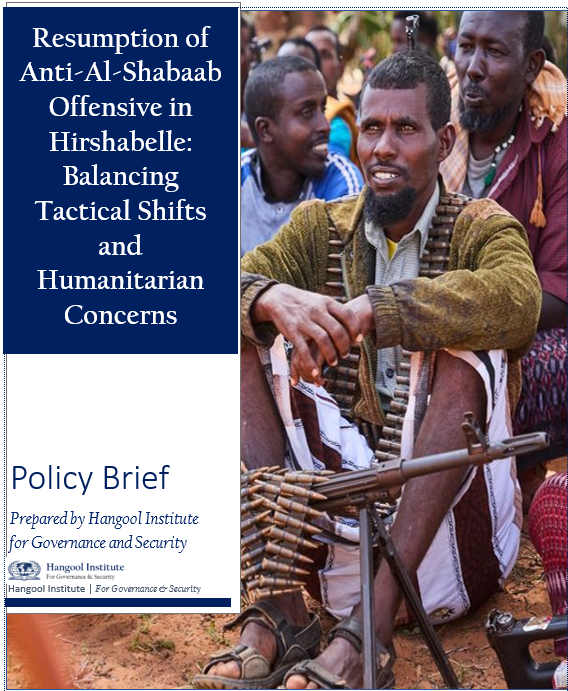
Policy Brief
Prepared by Hangool Institute | For Governance & Security.

_____________________________________________
Executive Summary
The Federal Government of Somalia has resumed its offensive against Al-Shabaab (AS) in the Hirshabelle region, with local clan militias (Macawisley) taking the lead in ground operations, supported by the Somali National Army (SNA) and African Union Support and Stabilization Mission in Somalia (AUSSOM). While initial gains have been made, the Macawisley militias face exhaustion and limited capacity, raising concerns about the sustainability of the offensive. The operation has also triggered civilian displacement and humanitarian challenges. This brief analyzes the tactical shift, identifies key challenges, and provides recommendations to enhance the effectiveness of the offensive while mitigating humanitarian risks.
Introduction
The resumption of anti-Al-Shabaab operations in Hirshabelle marks a significant shift in Somalia’s counterinsurgency strategy. By empowering local militias like the Macawisley, the Federal Government aims to leverage their local knowledge and resilience. However, the offensive faces challenges, including militia exhaustion, Al-Shabaab’s counteroffensive tactics, and humanitarian concerns.
This brief, based on research conducted by the Hangool Institute, examines the implications of this tactical shift and offers policy recommendations to ensure long-term success.
Key Challenges
1. Militia Exhaustion and Limited Capacity
- The Macawisley militias, while resilient, are reportedly exhausted and lack the resources to sustain prolonged operations against Al-Shabaab’s well-planned counteroffensives.
- Without robust support from federal and international forces, the militias risk being overrun.
2. Al-Shabaab’s Counteroffensive Tactics
- Al-Shabaab is expected to employ hit-and-run tactics, exploit AUSSOM transitions, and target SNA and Macawisley positions to regain lost territory.
- The group’s ability to infiltrate key areas, such as Beera Yabaal, poses a persistent threat.
3. Humanitarian Concerns
- The Federal Government’s warning to civilians in AS-held territories has caused fear and displacement, exacerbating humanitarian challenges.
- Intensified operations could lead to further population displacement, straining urban centers and humanitarian resources.
4. Coordination Gaps
- Limited impact from recent rocket attacks by government and AUSSOM forces highlights the need for better coordination and strategic planning.
Policy options
1. Enhanced Support for Local Militias
- Provide the Macawisley with training, equipment, and logistical support to bolster their capacity.
- Establish joint command structures to improve coordination between militias, SNA, and AUSSOM forces.
2. Strengthened Intelligence and Surveillance
- Deploy drones and other surveillance technologies to monitor AS movements and preempt counteroffensives.
- Share real-time intelligence with local militias to enhance their operational effectiveness.
3. Humanitarian Safeguards
- Develop a clear humanitarian plan to protect civilians and manage displacement, including safe corridors and temporary shelters.
- Collaborate with international organizations to provide aid and support to affected communities.
4. Strategic Communication
- Launch a public awareness campaign to clarify the objectives of the offensive and reassure civilians.
- Counter AS propaganda by highlighting the government’s commitment to restoring security and stability.
Recommendations
1. Immediate Reinforcement of Macawisley Militias
- Equip and train local militias to ensure they can sustain operations and withstand AS counteroffensives.
2. Improved Coordination Between SNA, AUSSOM, and Local Forces
- Establish integrated command centers to streamline operations and enhance tactical effectiveness.
3. Humanitarian Assistance and Protection
- Prioritize civilian safety by creating evacuation plans and providing humanitarian aid to displaced populations.
4. Long-Term Capacity Building
- Invest in the professionalization of local militias and SNA forces to ensure sustainable security gains.
Conclusion
The resumption of anti-Al-Shabaab operations in Hirshabelle represents a critical opportunity to weaken the militant group’s hold on the region. However, the success of this offensive hinges on addressing the challenges faced by local militias, improving coordination among security forces, and mitigating humanitarian risks. By adopting a comprehensive and inclusive approach, the Federal Government of Somalia can achieve lasting security gains while safeguarding civilian well-being.
References
- Reports from the Somali National Army (SNA) and African Union Support and Stabilization Mission in Somalia (AUSSOM).
- Statements from Ali Jeyte Osman, advisor to the President of Somalia.
- Field observations and analysis of recent clashes in Hirshabelle.
This policy brief provides a framework for addressing the complexities of the ongoing offensive. For further inquiries or detailed analysis, please contact the Hangool Institute for Security and Governance.


